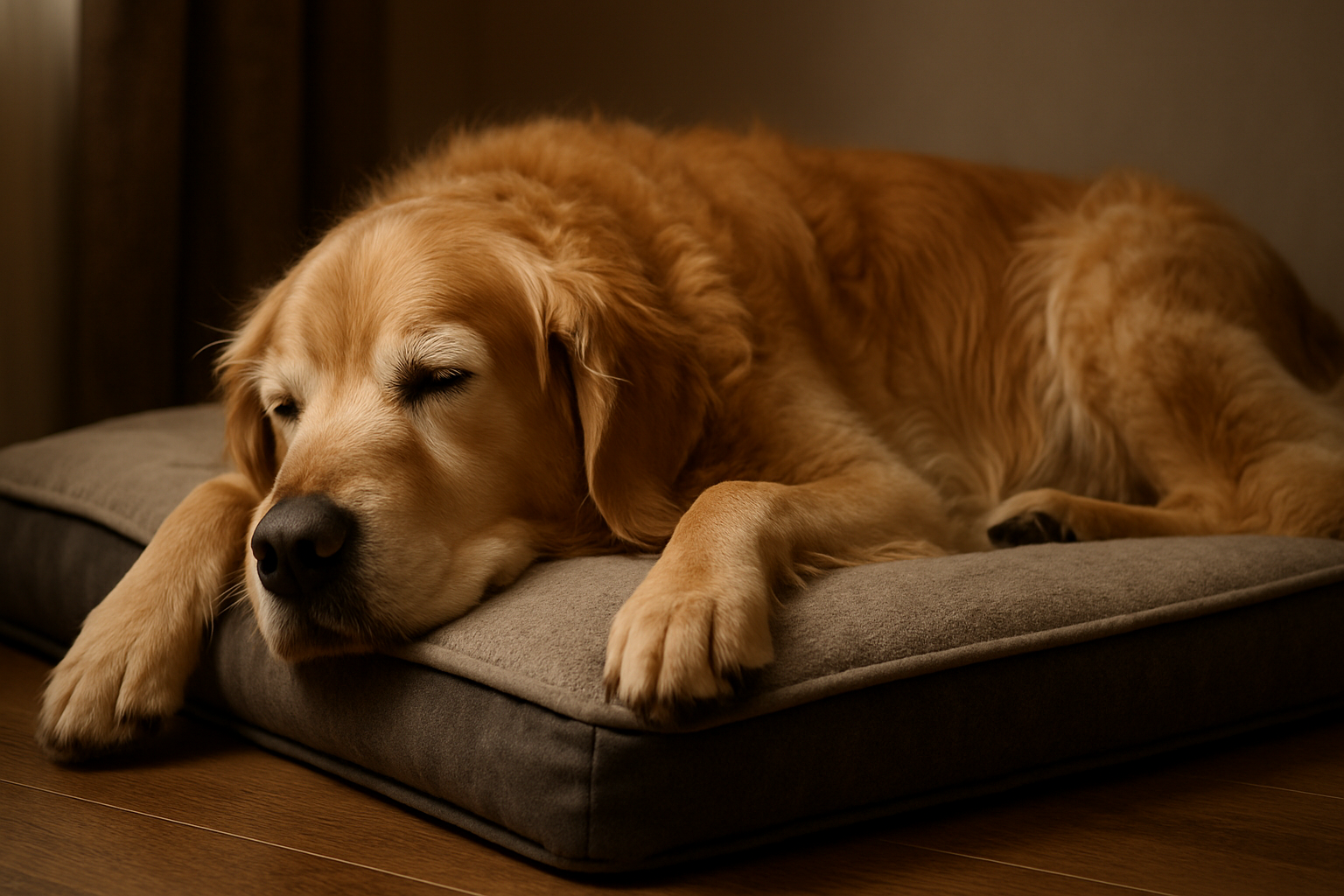Creating tranquil, supportive environments becomes increasingly important for senior Golden Retrievers as aging can bring heightened sensitivity to stress, noise, and environmental changes that may have been easily tolerated in their younger years. Understanding how to design and maintain peaceful surroundings helps support emotional well-being while promoting physical comfort and quality of life.
Senior Golden Retrievers benefit from environments that minimize stressors, provide comfortable retreat spaces, and support their changing sensory and physical needs. These carefully designed spaces help reduce anxiety, promote restful sleep, and create sanctuaries where aging dogs can feel secure and comfortable throughout their daily routines.
Effective environmental design for senior dogs encompasses lighting considerations, noise management, temperature control, comfortable furnishing, and spatial arrangements that accommodate mobility changes while maintaining access to family life and social connections that remain important for emotional well-being.
Understanding Environmental Stress Factors
Age-Related Sensitivity Changes
Increased Noise Sensitivity
Senior Golden Retrievers often develop increased sensitivity to sounds that previously caused no distress, including household noises, traffic sounds, or sudden loud noises that can create anxiety and stress responses.
Hearing changes that commonly occur with aging can make some sounds seem distorted or more startling, requiring environmental modifications that reduce acoustic stress while maintaining necessary sound awareness.
Understanding individual sound sensitivities helps families identify and modify noise sources that may be contributing to stress or anxiety in their senior companions while creating more peaceful living environments.
Light and Visual Sensitivity
Vision changes in senior dogs can create increased sensitivity to bright lights, glare, or sudden lighting changes that may cause discomfort or disorientation in environments that were previously comfortable.
Reduced visual acuity may make navigation more challenging in poorly lit areas while bright lights can cause discomfort or confusion, requiring balanced lighting approaches that support both comfort and safety.
Understanding visual needs helps guide lighting design that supports senior dogs’ ability to navigate safely while providing comfortable illumination that doesn’t cause stress or discomfort.
Environmental Stressor Identification
Household Activity Impact
Busy household environments with high activity levels, frequent visitors, or constant movement can become overwhelming for senior Golden Retrievers who may prefer calmer, more predictable surroundings.
Understanding how activity levels affect senior dogs helps families balance normal household life with the need for peaceful environments that support comfort and emotional well-being.
Recognition of individual tolerance levels helps guide household management that maintains family life while providing appropriate quiet spaces and calm periods for senior dog comfort.
Spatial Arrangement Considerations
Furniture placement, pathway accessibility, and spatial organization can significantly impact senior dog comfort and stress levels, particularly for dogs with mobility limitations or cognitive changes.
Understanding spatial needs helps families arrange living areas that support easy navigation while providing comfortable access to important resources such as food, water, and resting areas.
Environmental barriers or hazards that create navigation challenges can increase stress and anxiety, making thoughtful spatial design important for senior dog peace and security.
Lighting and Visual Environment Optimization
Natural Light Management
Balanced Illumination Strategies
Providing consistent, gentle natural lighting helps support senior dogs’ circadian rhythms while offering comfortable illumination that doesn’t create harsh contrasts or glare that might cause visual discomfort.
Understanding the benefits of natural light helps families optimize window treatments and positioning that provide appropriate illumination while controlling excessive brightness that might be uncomfortable.
Gradual lighting transitions throughout the day help support natural rhythms while avoiding sudden changes that might be startling or disorienting for senior dogs with vision changes.
Glare Reduction Techniques
Minimizing glare from windows, reflective surfaces, or direct lighting helps create more comfortable visual environments for senior dogs who may be more sensitive to bright or harsh lighting.
Understanding glare sources helps families identify and modify lighting conditions that may be contributing to visual discomfort or navigation difficulties for senior companions.
Window treatments, lamp positioning, and surface material choices can all contribute to glare reduction while maintaining appropriate illumination levels for safety and comfort.
Artificial Lighting Considerations
Gentle Evening Illumination
Providing soft, warm lighting during evening hours helps senior dogs navigate safely while avoiding harsh lighting that might interfere with natural sleep preparation and relaxation routines.
Understanding the importance of lighting transitions helps families create environments that support natural sleep cycles while maintaining safety for senior dogs who may need to move around during nighttime hours.
Night lighting should be sufficient for safety without being so bright as to interfere with rest or create discomfort for dogs who may be light-sensitive.
Peaceful Environment Design Guide
| Environmental Element | Stress Reduction Strategies | Comfort Enhancement | Senior-Specific Adaptations | Monitoring Indicators |
|---|---|---|---|---|
| Lighting | Soft, consistent illumination | Natural light optimization | Reduce glare, gentle transitions | Relaxed posture, normal activity |
| Sound Environment | Noise reduction, soft music | Consistent background sounds | Avoid sudden loud noises | Calm behavior, normal sleep |
| Temperature Control | Stable, comfortable warmth | Draft elimination | Extra warmth provision | Comfortable positioning, no shivering |
| Furniture Arrangement | Clear pathways, stable surfaces | Comfortable access | Non-slip surfaces, lower heights | Easy navigation, confident movement |
| Rest Areas | Multiple quiet spaces | Orthopedic support | Easy access, privacy options | Voluntary rest use, relaxed sleeping |
| Safety Features | Hazard elimination | Secure boundaries | Fall prevention, soft surfaces | Confident exploration, no accidents |
Sound Environment Management
Noise Reduction Strategies
Acoustic Control Methods
Using soft furnishings, carpets, and sound-absorbing materials helps reduce echo and harsh sounds while creating more peaceful acoustic environments that support relaxation and comfort.
Understanding how different materials affect sound transmission helps families make choices that contribute to quieter, more comfortable living spaces for sound-sensitive senior dogs.
Strategic placement of furniture and decorative items can help buffer sounds while creating natural sound barriers that reduce noise transmission from high-activity areas.
Background Sound Benefits
Gentle background sounds such as soft music, nature sounds, or white noise can help mask household noises while creating consistently peaceful auditory environments.
Understanding the calming effects of appropriate background sounds helps families select audio environments that promote relaxation while reducing stress from unpredictable noise sources.
Consistent, gentle background sounds can help senior dogs feel more secure while providing auditory comfort that supports rest and relaxation throughout the day.
Sound Source Management
Household Noise Control
Identifying and managing sources of household noise such as television volume, appliance sounds, or family activity levels helps create more peaceful environments for senior dogs.
Understanding individual noise sensitivities helps families make adjustments that reduce stress without completely eliminating normal household sounds and activities.
Timing of noisy activities can be managed to provide quiet periods when senior dogs typically rest or sleep, supporting their need for peaceful recovery time.
External Noise Buffering
Using landscaping, window treatments, or structural modifications to reduce external noise from traffic, neighbors, or other sources helps create more peaceful indoor environments.
Understanding external noise sources helps families implement appropriate buffering strategies that reduce stress while maintaining connection to outdoor environments when desired.
Creating quiet zones within homes helps provide retreat areas where external noises are minimized, offering peaceful spaces for senior dogs when they need respite from stimulation.
Temperature and Climate Control
Thermal Comfort Optimization
Consistent Temperature Maintenance
Senior Golden Retrievers often require more stable temperatures as their ability to regulate body temperature may be compromised, making consistent climate control important for comfort.
Understanding temperature needs helps families maintain environments that support comfort without creating energy inefficiency while ensuring that senior dogs remain comfortable throughout daily temperature variations.
Avoiding temperature extremes and sudden changes helps prevent stress while supporting the senior dog’s reduced ability to adapt to thermal variations.
Draft Elimination
Identifying and blocking cold drafts helps maintain comfortable temperatures while preventing the discomfort that can result from cold air movement that affects senior dogs more significantly than younger animals.
Understanding air flow patterns helps families identify problem areas while implementing solutions that maintain air quality while eliminating uncomfortable drafts.
Providing warm, draft-free resting areas ensures that senior dogs have access to comfortable spaces regardless of weather conditions or seasonal temperature changes.
Seasonal Comfort Adaptations
Winter Warmth Provision
Additional heating sources such as heated beds, warming mats, or space heaters (used safely) help provide extra warmth that supports comfort during cold weather periods.
Understanding winter comfort needs helps families prepare environments that maintain warmth while ensuring safety and preventing overheating or fire hazards from heating devices.
Layered bedding and warm sleeping areas help senior dogs maintain comfortable body temperatures while providing choices in warmth levels based on individual preferences.
Summer Cooling Support
Providing cooling options such as fans, air conditioning, or cooling mats helps senior dogs maintain comfortable temperatures during warm weather when heat regulation may be challenging.
Understanding cooling needs helps families create comfortable summer environments while monitoring for signs of overheating that can be particularly dangerous for senior dogs.
Access to cool surfaces, shaded areas, and adequate ventilation helps support temperature regulation while maintaining comfort during challenging weather conditions.
Furniture and Spatial Arrangements
Accessibility and Safety Design
Pathway Optimization
Creating clear, wide pathways helps senior dogs navigate safely while accommodating potential vision changes or mobility limitations that may affect their ability to move through spaces.
Understanding navigation needs helps families arrange furniture and belongings that support easy movement while preventing obstacles that could cause falls or injuries.
Consistent furniture placement helps senior dogs learn and remember spatial arrangements, supporting confident navigation even when vision or cognitive changes affect spatial awareness.
Surface Safety Considerations
Providing non-slip surfaces, secure rugs, and stable flooring helps prevent falls while supporting confident movement for senior dogs who may have balance or coordination challenges.
Understanding surface safety helps families identify and modify slippery or unstable surfaces that could pose risks while maintaining attractive and functional living spaces.
Appropriate surface materials support joint comfort while providing adequate traction that enables safe movement throughout daily activities and routines.
Comfort Zone Creation
Multiple Rest Area Provision
Offering various comfortable resting areas throughout the home allows senior dogs to choose locations based on temperature preferences, social proximity desires, or comfort needs.
Understanding rest area variety helps families create options that accommodate changing preferences while ensuring that comfortable spaces are available in different areas of the home.
Strategic rest area placement provides choices between social interaction and solitude, allowing senior dogs to regulate their social exposure based on daily energy and comfort levels.
Resource Accessibility
Ensuring easy access to food, water, and elimination areas helps reduce stress while supporting independence for senior dogs who may have mobility limitations.
Understanding accessibility needs helps families arrange resources that support easy use while maintaining dignity and independence in daily care routines.
Multiple resource locations can provide options that accommodate changing mobility while ensuring that basic needs can be met comfortably throughout the home.
Stress Reduction Through Environmental Design
Calming Color and Texture Choices
Visual Comfort Elements
Selecting calming colors, soft textures, and visually peaceful elements helps create environments that promote relaxation while reducing visual stimulation that might contribute to stress or anxiety.
Understanding color psychology and visual comfort helps families make design choices that support emotional well-being while creating pleasant living environments for all family members.
Natural materials and earth tones often provide calming visual environments while avoiding stark contrasts or busy patterns that might be overstimulating for senior dogs.
Texture Comfort Provision
Providing soft, comfortable textures through bedding, furniture covers, and flooring helps create tactile comfort that supports relaxation and physical comfort.
Understanding texture preferences helps families select materials that provide comfort while maintaining cleanliness and durability appropriate for pet households.
Variety in texture options allows senior dogs to choose surfaces that feel most comfortable while accommodating changing preferences or physical needs.
Aromatherapy and Scent Management
Natural Calming Scents
Using gentle, dog-safe aromatherapy or natural scents can help create calming environments while avoiding artificial fragrances that might be overwhelming or irritating to sensitive senior dogs.
Understanding safe scent options helps families create pleasant environments while ensuring that aromatic choices support rather than stress senior dogs with potentially sensitive respiratory systems.
Subtle, natural scents from plants or essential oils (used safely) can contribute to peaceful environments while providing olfactory comfort that supports relaxation.
Odor Control Strategies
Maintaining clean, fresh-smelling environments helps prevent odor buildup that could cause stress or discomfort while supporting healthy living conditions for senior dogs and families.
Understanding odor sources and control methods helps families maintain pleasant environments while addressing any hygiene challenges that may arise with senior dog care.
Natural odor control methods help maintain freshness while avoiding harsh chemicals that might be irritating to senior dogs with sensitive respiratory or skin conditions.
Technology Integration for Environmental Control
Automated Comfort Systems
Climate Control Automation
Programmable thermostats and automated climate control systems help maintain consistent temperatures while ensuring comfort without constant manual adjustment.
Understanding automation benefits helps families create consistently comfortable environments while reducing the management burden of maintaining optimal conditions.
Smart home technology can provide remote monitoring and control that ensures senior dogs remain comfortable even when families are away from home.
Lighting Control Systems
Automated lighting systems can provide gentle transitions between day and night lighting while ensuring adequate illumination for safety without harsh changes that might be startling.
Understanding lighting automation helps families create supportive environments while reducing the need for manual adjustments that might be forgotten or inconvenient.
Timed lighting systems can support natural circadian rhythms while providing appropriate illumination for senior dogs’ changing visual needs throughout different times of day.
Monitoring and Alert Systems
Environmental Monitoring
Temperature and humidity monitors help families track environmental conditions while ensuring that comfort parameters remain within appropriate ranges for senior dog health.
Understanding monitoring benefits helps families maintain optimal conditions while identifying potential problems before they affect senior dog comfort or health.
Alert systems can notify families of environmental changes that might require attention, ensuring prompt response to conditions that could affect senior dog well-being.
Long-Term Environmental Maintenance
Adaptation and Evolution
Changing Needs Assessment
Regular evaluation of environmental effectiveness helps families identify when modifications may be needed to continue supporting senior dog comfort as their needs evolve with age.
Understanding that environmental needs may change helps families remain flexible while maintaining the peaceful, supportive conditions that benefit senior dog well-being.
Ongoing assessment ensures that environmental modifications continue to provide benefits while adapting to changing health conditions or preferences.
Seasonal Adjustments
Planning for seasonal environmental changes helps maintain consistent comfort while adapting to weather conditions and changing daylight patterns that affect senior dog needs.
Understanding seasonal impacts helps families prepare appropriate modifications while ensuring that environmental support remains effective throughout the year.
Proactive seasonal planning helps prevent environmental stress while maintaining the peaceful conditions that support senior dog comfort and well-being.
Creating calm and peaceful environments for senior Golden Retrievers requires thoughtful attention to their changing sensory needs, comfort requirements, and stress sensitivities. Through careful environmental design, families can provide supportive surroundings that promote relaxation, reduce anxiety, and enhance quality of life throughout the aging process.
Success in environmental design comes from understanding individual needs while creating flexible spaces that can adapt to changing requirements over time. With proper attention to lighting, sound, temperature, and spatial arrangements, families can create havens of peace that support their senior companions’ emotional and physical well-being.
The investment in creating peaceful environments demonstrates commitment to comprehensive senior dog care while providing the foundation for comfort and security that enhances daily life and supports successful aging in place.

Rafael Souza is a digital marketing strategist and lifelong dog enthusiast. Passionate about Golden Retrievers, he shares practical, research-based tips to help owners provide healthier and happier lives for their furry companions.






1 thought on “Creating Calm and Peaceful Environments for Senior Golden Retrievers”